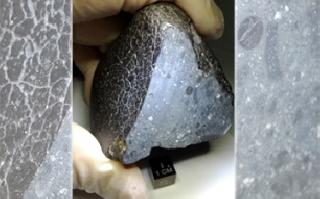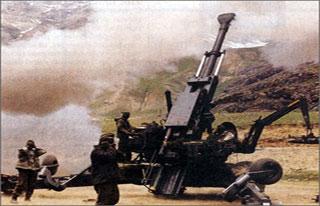
The NWA 7034 Martian meteorite. A NASA photo
WASHINGTON (PTI): A 2-billion-year-old dark lump of rock that landed in Sahara desert is actually a new type of Martian meteorite, containing 10 times more water than usual, according to scientists.
This new class of meteorite was found in 2011 in the Sahara Desert. Designated Northwest Africa (NWA) 7034, and nicknamed "Black Beauty," it weighs approximately 320 grams.
After more than a year of intensive study, a team of US scientists determined the meteorite formed 2.1 billion years ago during the beginning of the most recent geologic period on Mars, known as the Amazonian.
"The age of NWA 7034 is important because it is significantly older than most other Martian meteorites," said Mitch Schulte, programme scientist for the Mars Exploration Programme at NASA Headquarters in Washington.
"We now have insight into a piece of Mars' history at a critical time in its evolution," said Schulte.
The meteorite is an excellent match for surface rocks and outcrops NASA has studied remotely via Mars rovers and Mars-orbiting satellites, NASA said in a statement.
NWA 7034's composition is different from any previously studied Martian meteorite. The research is published in journal of Science Express.
"The contents of this meteorite may challenge many long held notions about Martian geology," said John Grunsfeld, associate administrator at NASA's Science Mission Directorate.
"These findings also present an important reference frame for the Curiosity rover as it searches for reduced organics in the minerals exposed in the bedrock of Gale Crater," he said.
NWA 7034 is made of cemented fragments of basalt rock that forms from rapidly cooled lava. The fragments are primarily feldspar and pyroxene, most likely from volcanic activity.
This unusual meteorite's chemistry matches that of the Martian crust as measured by NASA's Mars Exploration Rovers and Mars Odyssey Orbiter.
"This Martian meteorite has everything in its composition that you'd want in order to further our understanding of the Red Planet," said Carl Agee, leader of the analysis team.
"This unique meteorite tells us what volcanism was like on Mars 2 billion years ago. It also gives us a glimpse of ancient surface and environmental conditions on Mars that no other meteorite has ever offered," said Agee.
Researchers theorise the large amount of water contained in NWA 7034 may have originated from interaction of the rocks with water present in Mars' crust. The meteorite also has a different mixture of oxygen isotopes than has been found in other Martian meteorites, which could have resulted from interaction with the Martian atmosphere.
 Previous Article
Previous Article Next Article
Next Article











The Indian Air Force, in its flight trials evaluation report submitted before the Defence Ministry l..
view articleAn insight into the Medium Multi-Role Combat Aircraft competition...
view articleSky enthusiasts can now spot the International Space Station (ISS) commanded by Indian-American astr..
view article